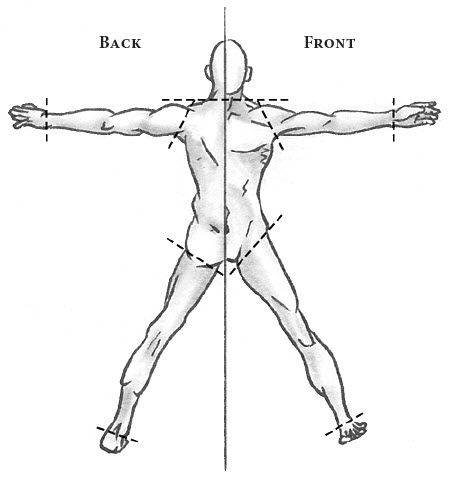Hit Location
From AmtWiki
Hit Locations
Players have five locations which may be wounded: left arm, right arm, left leg, right leg, and torso.
- Arm: From just below the outside point of the shoulder to the tips of the fingers.
- A hand is not wounded if struck below the wrist while wielding a melee weapon, shield, or bow. Treat hits below the wrist to a hand wielding a melee weapon, shield, or bow as though they had hit the melee weapon, shield, or bow wielded instead.
- Leg: From just below the end of the buttocks in the back, the hip socket in the front, and an imaginary line between them on the sides down to and including the foot.
- A foot on the ground is not wounded if struck below the ankle and all effects of weapons, projectiles, and Magic Balls are ignored.
- Torso: Everything that isn’t an arm or leg, including the groin, shoulders, and collar bones up to the vertical rise of the neck.
Notes
- Players may not be struck in the neck or head. A strike to the head is invalid, and will not count as a hit.
- Players may not block shots with their neck or head. Intentional head blocking can result in being called dead by a reeve.
- A wounded arm may carry equipment, but may not wield equipment or cast abilities, and must be kept out of combat. A wounded arm is capable of receiving an additional wound.
- Players who receive a leg wound must decide if they are going to kneel or post with that leg. A player can switch between kneeling and posting by declaring as such with no living enemies within 20', or when instructed by a reeve.
- a. If a player chooses to kneel, their wounded leg must have the knee in contact with the ground. The knee of the wounded leg may be lifted from the ground briefly to enable movement so long as the unwounded leg has a knee on the ground.
- b. If a player chooses to post, the player must immediately notify their opponent(s) of this by stating “posting”. While posting, the player may not voluntarily move the foot of the wounded leg, although it may be used to pivot.
- Players with a wounded leg who are affected by abilities which allow or require movement may choose to ignore the requirement for dead legs to have the knee on the ground (or, if "posting," to not voluntarily move the foot of the wounded leg) for the purposes of completing the movement. While moving in this manner, the wounded player may not attack or cast abilities, but may defend themselves. Once the player has completed the movement, they must once again place their knee in contact with the ground, or re-declare "posting". This ‘forced movement accommodation' may not be used for the ability Blink.
- A wounded leg is capable of receiving an additional wound (even if “posting”), except when the knee is on the ground or during the initial placement of the knee on the ground after receiving a wound.
- A player with a wounded leg may ‘hobble' by declaring "hobbling" and then moving slowly, taking no more than one step per second, and dragging a leg as long as there are no living enemies within 20'. While moving in this manner, the wounded player must chant “hobbling” and may not attack or cast abilities, but may defend themselves. Afterwards, the player must either kneel or re-declare "posting".
Combat Rules Hit Location · Combat Contact · Inflicting Wounds · Deaths · Combat Notes · Combat Etiquette
Retrieved from "https://wiki.amtgard.com/index.php?title=Hit_Location&oldid=270546"
